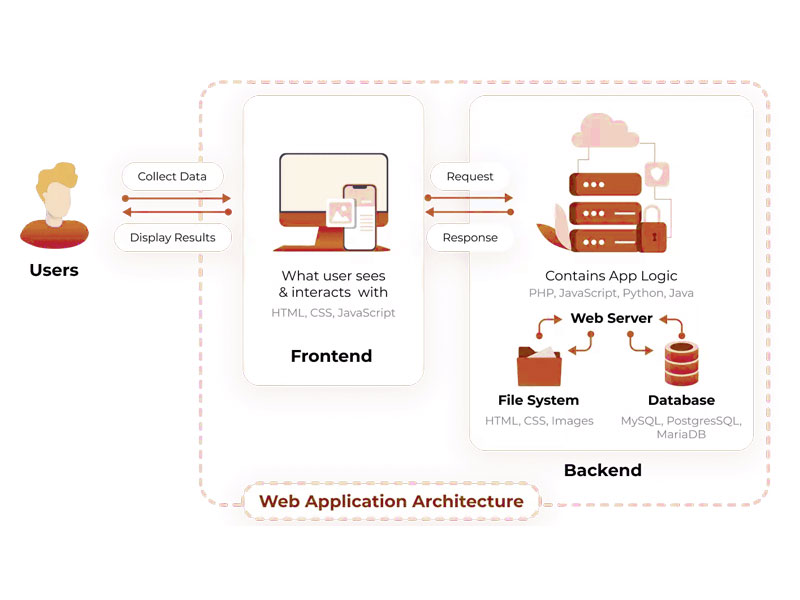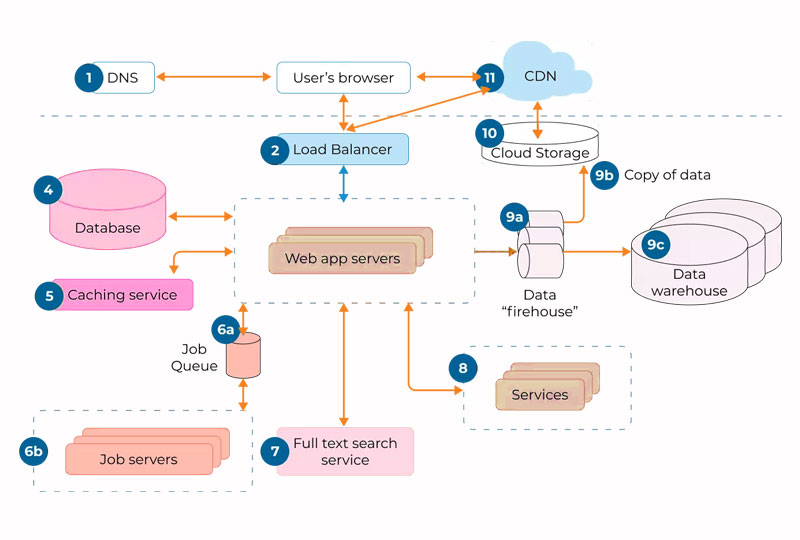Ever contemplated the effective scaling of a web app? The web application architecture is crucial in this circumstance for laying the groundwork for your app. To satisfy your company’s needs and objectives, you must comprehend the idea, traits, and function of the an architecture. This blog will introduce you to the
- What is web application architecture?
- Types of web application architecture
- Components of web app architecture
- Layers of web app architecture
- Models of web application architecture
- How do modern web applications work?
- Key aspects to consider before creating a top-notch web app architecture
- How to design modern web application architecture?
Ultimate Guide to Fundamentals of Web App Architecture
These terms, User interfaces, middleware systems, databases, servers, and the browser might seem inconsequential to you, but these form the very foundation of your interaction with the web. How you see, load, and access material, information, data, and multimedia over the internet – all of this is defined by how a few underlying components and structures interact and behave.
These fundamental concepts are what is called Web Application architecture.
Now any software firm or developer worth their salt knows that a web app architecture is absolutely pivotal in deciding whether an app can achieve success.
So in this overview, we’ve tried to combine some vital information about how web apps work, what are the components in a web application’s architecture, and how you can craft a seamless web app. Let’s have a look.
What is Web Application Architecture?
The architecture of a web application defines the schematic representation of the components, including middleware, data, and programs. It specifies the HTTP data delivery process and guarantees that both the client-side and backend server can comprehend it. Additionally, it ensures that all user requests contain correct data. It authenticates and permits access while also creating and managing records.
So at its bare definition, Webapp architecture defines the interactions that happen behind the scenes whenever you press GO in a browser search.

Why is investing in and considering Webapp architecture important?
Well, in essence, Webapp architecture focuses on providing scalability, enabling device, and platform interoperability, and improving reliability, and security.
Considering its essential aspects, it’s absolutely important for a CTO or a project manager to focus on the web app architecture and ensure a robust system to manage the assortments of requests and interactions that a web app offers.
Types of Web Application Architecture
Frontend:
- Single-Page Application (SPAs)
The popularity of single-page applications (or SPAs) grew in response to the long-standing problems with slow-loading sites that significantly hampered browsing experience and commercial traffic. As a result, rather than reloading a new page every time a viewer wants to perform any action, SPAs enable the dynamically reloading of required data alongside updated information within the same page.
- Server-Side Rendered Application (SSR)
SSR converts webpages built with client-side JavaScript frameworks to HTML and CSS on the server end. Delivering important files swiftly is made feasible with SSR, which decreases load times and speeds up user page loading.
Backend:
- Microservices
Microservices are a lightweight component of the SOA (service-oriented architecture) that carry out simple tasks such as the implementation of a single or a small number of services. If you’re working on a big, complicated project, this architecture is an excellent choice.
- Serverless Architecture
Let’s say your app encounters an unexpectedly high volume of traffic that your systems are ill-equipped to handle. Will the application collapse as a result of this? No! In this scenario, serverless architecture is relevant. This lets programmers work with third-party technology rather than backend servers.

Components of Web App Architecture
Structural components
The functions that control how people interact with a web application are incorporated into structural components. They consist of two parts:
- User component:
The CSS, HTML, or JS is used to generate this component. A user accesses this section of a web app. You don’t need to make any operating system or device-specific adjustments for this component because it already resides inside the user’s browser.
- Server component:
This is created using a single or a combination of programming languages and frameworks. Database and logic are two separate elements. The logic component displays the app’s core functionality, while the database contains all permanent data.
UI/UX Components
A web app’s foundational architecture includes the UI/UX component. This component is in charge of giving a web application visual presentation and assisting users to have a seamless experience.
Layers of Web App Architecture
- Presentation Layer (PL)
The user interaction with the application is made easier thanks to the presentation layer’s assistance in making a connection between both the web browser and the app’s UI. The frameworks JavaScript, HTML, and CSS are used to generate each presentation layer.
- Business Layer (BL)
This layer assists in handling the client requirements executes business logic on the requirements and returns the results to the preceding layer. This layer is largely responsible for determining the application’s business rules.
- Data Access Layer (DAL)
The data access layer is responsible for gaining data that is stored in XML, binary files, as well as other sources. It also aids in processes such as establishing, viewing, modifying, and erasing.
- Data Service Layer (DSL)
Finally, the data service layer maintains security and privacy and saves all data. This layer protects information by isolating the application’s business logic.
Models of Web Application Architecture
1. One web server one database model
Since all requests are handled by a single server and single database, this model is somewhat out of date. Thus, your application will also stop working if a server crashes. But if you’re a startup owner with limited resources, it is an excellent solution because it is typically utilized for testing operations.
2. Multiple web servers and one database model
A backup server is present under this model, minimizing the possibility of data loss in case one server fails. There is a single database available, thus there is still a potential that the site might crash.
3. Multiple web servers, multiple database models
Due to the availability of two alternatives for data storage, the threat to the application’s efficiency is lower. You can either save the same information in every database or spread it equally across all servers.
How do Modern Web Applications Work?
- In order to obtain the IP address, the user (browser) gets in touch with a DNS server.
- Following that, the browser contacts the server to obtain web pages.
- According to the viewer’s access permission, the server passes that onto the application logic (business layer), which chooses the correct plan of action.
- The application logic pulls information from the server and transmits them to the browser.
- When a web page with data is received, it is parsed by the browser, as well as any fixed assets (such as JavaScript, CSS, pictures, and videos) are then loaded from the CDN.
- The JavaScript layer, which is often included in modern web apps, connects the app logic to the backend and other web browsers’ APIs.
- The information can be viewed as a webpage by the browser when it is rendered.
Key aspects to consider before creating a top-notch web app architecture:
- Consistency – You must evaluate the requirements of the app to choose a solution that meets the majority of the development objectives. Additionally, this should also offer a standard method for tackling all the development difficulties.
- System adaptability – Create an architecture that supports both Macs and Windows in order to reach a wide range of audiences.
- Timely bug discovery – In order to detect bugs quickly and in a timely manner, make sure to design architecture capable of detecting them promptly. By doing so, you will be able to solve the problem quickly.
- Faster responsiveness and load times – Maintain a responsive and efficient architecture. Define the requirements for the product by examining and comparing the best web apps in the market in terms of responsiveness and loading speed.
- Outstanding security measures – The web application may become susceptible if the source code itself is not secured, thus the app architecture must be robust enough to safeguard sensitive data and adhere to privacy regulations like HIPAA and GDPR.
- Not crashing – The web app architecture must be created to prevent crashes and to enable self-healing in the event that they do occur. Furthermore, it is crucial to avoid any failure because doing so would make restarting very challenging.
Once you keep these points in mind, you can start creating architecture for your web app. Let’s take a look at how you can do it.
How to Design Modern Web Application Architecture?
Backend
A system that is appropriate for the website domain’s dynamic and static character must be chosen for the backend. The ideal option is to choose a server with language that complements one another.
Regarding memory and CPU needs, cloud services may be used to implement a microservices architecture or a serverless architecture. Furthermore, the online applications run on microservices that provide interaction by HTTP or Queue, which supports a variety of languages.
Database
It is important to choose a database that will provide a variety of functions, including SQL and NoSQL. Both systems are distinct from one another because NoSQL focuses on key-value structures, and objects, while SQL is mostly on predetermined plans and tables.
API
The use of API, which relies on POST, REST, and GET, is yet another crucial component of the architecture. An HTTP request may be readily managed via these APIs.
Frontend
Selecting single-page applications and model view controllers is also another aspect of web app design. It is important to think about the needs and what would work well in both scenarios when choosing a certain kind of architecture.
Web Application Architecture – How Netsmartz can help?
The fact is that selecting the appropriate tech stack may appear difficult, but it all depends on your project’s needs and the recommendations of the developers. Furthermore, if you’re a startup owner who is troubled by the concept, then consider outsourcing. If you are considering outsourcing it, you will be better off relying on experienced professionals like Netsmartz for web app development.
A web application’s speed and usefulness are directly related to its architecture. It defines how quick and reliable your online application is, what the finished interface is like, as well as how the application performs in SERP.
At Netsmartz, we recognize the value of understanding our client’s requirements while being on the same page with them. As a result, every time we design a web application, we continuously keep in touch with our clients to ensure that the tool we give will improve their business operations.
Simply get in touch with us if you’re willing to discuss your idea and create a cutting-edge web application. Our skilled team of professionals is ready to assist you in determining which framework and architecture are suitable for your company while maintaining your startup’s goals and ambitions. So book a free consultation today!
Summary
Kickstart Your Project With Us!
Blog
Popular Posts
CONTACT US
Let's Build Your Agile Team.
Experience Netsmartz for 40 hours - No Cost, No Obligation.
Connect With Us Today!
Please fill out the form or send us an email to
 Don't Miss Out:
Don't Miss Out: 







